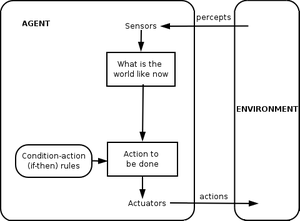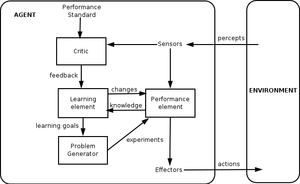“多智能体系统”的版本间的差异
(→研究) |
|||
| 第107行: | 第107行: | ||
* 以智能体为导向的软件工程 | * 以智能体为导向的软件工程 | ||
| − | * 信念,欲望和动机 beliefs, desires, and | + | * 信念,欲望和动机 beliefs, desires, and intentions(BDI) |
* 合作和协调 | * 合作和协调 | ||
* 分布式约束优化 distributed constraint optimization(DCOPs) | * 分布式约束优化 distributed constraint optimization(DCOPs) | ||
| 第120行: | 第120行: | ||
* 机器人学,<ref>{{citation|last1=Ahmed |first1=S. |pages=459 |last2=Karsiti |first2=M.N. |url=http://eprints.utp.edu.my/320/|title=2007 IEEE International Conference on Electro/Information Technology |year=2007|doi=10.1109/EIT.2007.4374547|contribution=A testbed for control schemes using multi agent nonholonomic robots |isbn=978-1-4244-0940-2 }}</ref>多机器人系统 (MRS) 和机器人集群 | * 机器人学,<ref>{{citation|last1=Ahmed |first1=S. |pages=459 |last2=Karsiti |first2=M.N. |url=http://eprints.utp.edu.my/320/|title=2007 IEEE International Conference on Electro/Information Technology |year=2007|doi=10.1109/EIT.2007.4374547|contribution=A testbed for control schemes using multi agent nonholonomic robots |isbn=978-1-4244-0940-2 }}</ref>多机器人系统 (MRS) 和机器人集群 | ||
| + | <br> | ||
== 框架 == | == 框架 == | ||
2020年12月3日 (四) 18:45的版本
多智能体系统 multi-agent system(MAS),也称多主体系统或自组织系统 self-organized system ,是一种由多个相互作用的智能体组成的计算系统。多智能体系统可以解决一些单个多智能体或单一性系统难以解决的问题。[1]其智能主要体现在条理性、功能性、程序性的行为方式,以及搜索算法和强化学习[2]上。
尽管多智能体系统和基于主体的模型 Agent-based model(ABM) 有着很多的重叠,但是它们并不总是相同的。基于主体的模型目标在于解释那些遵循简单规则、可能并不是很“智能”的主体表现出的集群行为,一般被用于天然系统的研究中,而非实践和工程中解决具体的问题。因此“基于主体的模型”这个词更多地用在科学研究中,而“多智能体系统”则更多地用于工程和技术。[3]有关多智能体系统的研究可能会对在线交易、[4] 灾害应急、[5][6] 社会结构建模[7]
等领域有着良好的应用价值。
概念
多智能体系统由智能体 Agent及其所处的环境组成。典型的多智能体系统研究的是软件智能体 software agent。然而,多智能体系统中的智能体也可以是机器人、人类或人类团体。多智能体系统还可以包含人类和其它智能体的组合。
不同智能体可以按照从简单到复杂的顺序分为如下几个类型:
- 被动智能体,[8]或“无目标智能体”(比如障碍物、苹果或在简单仿真中的钥匙)
- 具有简单目标的主动智能体[8](比如鸟群中的鸟、“掠食者-猎物模型 Lotka–Volterra”中的狼和羊)
- 认知智能体(可以进行复杂的计算)
智能体所处的环境可以分为:
- 虚拟的 Virtual
- 离散的 Discrete
- 连续的 Continuous
我们也可以从如下角度考察智能体所处的环境,如:可知性 accessibility(是否可以搜集到关于环境的完整信息)、确定性 determinism(行为造成的影响是否是确定的)、动态性 dynamics(同一时刻有多少智能体影响环境)、离散性 discreteness(智能体可以采取的行动是否是有限的)、时序性 episodicity(智能体在某一特定时段内的行为是否影响其它时段)[9]、维度性 dimensionality(环境是否具有鲜明的空间特征,以及智能体在做决策时是否考虑空间因素)。智能体的行为通常受到中间件 Middleware 的调控。[10]中间件使得人们可以管理可用资源、调控智能体,极大地方便了人们对于多智能体系统进行抽象设计。[11]
特点
多智能体系统中的智能体有如下几个重要特点:[12]
- 自主性:智能体至少是部分独立的,可以自我感知、自主行动。
- 局部视野:没有一个智能体可以掌握系统的全貌,或者由于系统十分复杂,没有一个智能体可以利用全局性的知识。
- 无中心性:不指定任何一个控制性的智能体(或者说多智能体系统不会退化为一个单一化系统)。[13]
自组织与自引导
即使所有单个智能体的策略都很简单,多智能体系统也可以表现出自组织、自引导等控制范式以及相关的复杂行为。当智能体之间可以在系统通信规范的约束下使用一些约定的语言来共享信息时,这种方法可能带来智能体间的共赢。例如知识查询操作语言 Knowledge Query Manipulation Language(KQML)和智能体通信语言 Agent Communication Language(ACL)是这类语言中的两个典型例子。
系统模式
很多多智能体系统是在计算机仿真中实现的,按照离散的“时间步长 time steps”逐步地演化。多智能体系统中的组分通常使用加权请求矩阵和加权响应矩阵进行通信。下面是几个加权请求矩阵的例子:
速度——非常重要: 最小每小时45英里 路径长度——中等重要:最大60,预期最大40 最大重量——不重要 协议优先级——常规
加权响应矩阵的例子:
最小速度:天气晴朗时50 路径长度: 晴天25,雨天46 协议优先级——常规 注意,救护车具有更高的优先级,你必须等待
“请求-响应-协议 challenge-response-contrac”方案在多智能体系统当中很常见,在这个方案中:
- 首先,一个智能体将一个“谁可以...?”形式的请求分发出去。
- 其次,与该请求相关的智能体会响应道:“我可以,前提是...”。
- 最后,双方一般会通过几次很短的沟通步骤达成一个协议。
同时,这个过程也会考虑其它的智能体、考虑协议的改进以及算法对智能体的约束。
多智能体系统经常使用的另一个通信模式是信息素 Pheromone。在此模式下,各智能体为附近的其它智能体留下信息素来传递信息。随着时间的推移,这些信息素可能“蒸发”或累积,也就是其权重的下降或上升。
性质
多智能体系统常常可以在没有干预的情况下为它们的问题找到最好的解决方案,这与物理现象有很高的相似性。比如在能量最小化的例子中,物理智能体倾向于在物理条件约束的世界中达到可能的最低能量。
系统还具有防止故障传播、自恢复和容错的特点,这主要是由于组件的冗余性。
研究
多智能体系统的研究是与单智能体和多智能体系统中复杂的人工智能问题解决和控制架构的开发和分析有关。[14]主要的研究主题包括:
- 以智能体为导向的软件工程
- 信念,欲望和动机 beliefs, desires, and intentions(BDI)
- 合作和协调
- 分布式约束优化 distributed constraint optimization(DCOPs)
- 组织
- 沟通
- 谈判
- 分布式问题求解
- 多智能体学习
- 智能体挖掘
- 科学化社群(比如生物的群体、语言的进化和经济体)[15][16]
- 依赖性和容错
- 机器人学,[17]多机器人系统 (MRS) 和机器人集群
框架
一些贯彻共同标准的框架已经出现了(例如 FIPA 和 OMG MASIF [18]标准)。JADE等框架可以为标准化的多智能体系统开发节省时间和精力。[19]
不过目前,FIPA 或 OMG 还没有主动维护任何标准。在工业领域中进一步开发软件智能体的努力主要来自 IEEE 工业电子协会的工业智能体技术委员会。[20]
应用
除了学术研究之外,多智能体系统在工业中也有应用。[21]它在现实世界中不仅被用于电脑游戏等图形应用程序,还已经延伸到了电影中。[22]它在网络和移动技术中实现自动和动态的负载平衡、高可扩展性和自愈网络的作用广为流传。除此之外,多智能体系统还被用于协同防御体系中。
其它应用[23]包括运输、[24] 物流、[25]制图、制造、电力系统、[26]智能电网[27]和地理信息系统。
此外,多智能体系统人工智能 Multi-agent Systems Artificial Intelligence(MAAI) 被用于模拟社会,以助力气候,能源,流行病学,冲突管理,儿童虐待等方面的工作。[28]一些致力于使用多智能体系统模型的组织包括社会系统建模中心 Center for Modelling Social Systems、社会模拟研究中心 Centre for Research in Social Simulation、政策建模中心 Centre for Policy Modelling以及国际建模与模拟学会 Society for Modelling and Simulation International。[29]
参见
参考文献
- ↑ 模板:Cite document
- ↑ "Multi Agent Systems - an overview". ScienceDirect Topics. 2016-01-01. Retrieved 2020-01-23.
- ↑ Niazi, Muaz; Hussain, Amir (2011). "Agent-based Computing from Multi-agent Systems to Agent-Based Models: A Visual Survey" (PDF). Scientometrics. 89 (2): 479–499. arXiv:1708.05872. doi:10.1007/s11192-011-0468-9.
- ↑ Rogers, Alex; David, E.; Schiff, J.; Jennings, N.R. (2007). "The Effects of Proxy Bidding and Minimum Bid Increments within eBay Auctions". ACM Transactions on the Web. 1 (2): 9–es. CiteSeerX 10.1.1.65.4539. doi:10.1145/1255438.1255441.
- ↑ Schurr, Nathan; Marecki, Janusz; Tambe, Milind; Scerri, Paul; Kasinadhuni, Nikhil; Lewis, J.P. (2005). "The Future of Disaster Response: Humans Working with Multiagent Teams using DEFACTO" (PDF).
{{cite journal}}: Cite journal requires|journal=(help) - ↑ Genc, Zulkuf; et al. (2013). "Agent-based information infrastructure for disaster management" (PDF). Intelligent Systems for Crisis Management. Lecture Notes in Geoinformation and Cartography: 349–355. doi:10.1007/_26.
- ↑ Sun, Ron; Naveh, Isaac. "Simulating Organizational Decision-Making Using a Cognitively Realistic Agent Model". Journal of Artificial Societies and Social Simulation.
- ↑ 8.0 8.1 Kubera, Yoann; Mathieu, Philippe; Picault, Sébastien (2010), "Everything can be Agent!" (PDF), Proceedings of the Ninth International Joint Conference on Autonomous Agents and Multi-Agent Systems (AAMAS'2010): 1547–1548
- ↑ 模板:Russell Norvig 2003
- ↑ Salamon, Tomas (2011). Design of Agent-Based Models. Repin: Bruckner Publishing. p. 22. http://www.designofagentbasedmodels.info/.
- ↑ Weyns, Danny; Omicini, Amdrea; Odell, James (2007). "Environment as a first-class abstraction in multiagent systems" (PDF). Autonomous Agents and Multi-Agent Systems. 14 (1): 5–30. CiteSeerX 10.1.1.154.4480. doi:10.1007/s10458-006-0012-0. Retrieved 2013-05-31.https://en.wikipedia.org/wiki/Defekte_Weblinks?dwl={{{url}}} Seite nicht mehr abrufbar], Suche in Webarchiven: Kategorie:Wikipedia:Weblink offline (andere Namensräume)[http://timetravel.mementoweb.org/list/2010/Kategorie:Wikipedia:Vorlagenfehler/Vorlage:Toter Link/URL_fehlt
- ↑ Wooldridge, Michael (2002). An Introduction to MultiAgent Systems. John Wiley & Sons. pp. 366. ISBN 978-0-471-49691-5.
- ↑ Panait, Liviu; Luke, Sean (2005). "Cooperative Multi-Agent Learning: The State of the Art" (PDF). Autonomous Agents and Multi-Agent Systems. 11 (3): 387–434. CiteSeerX 10.1.1.307.6671. doi:10.1007/s10458-005-2631-2.
- ↑ "The Multi-Agent Systems Lab". University of Massachusetts Amherst. Retrieved Oct 16, 2009.
- ↑ Cucker, Felipe; Steve Smale (2007). "The Mathematics of Emergence" (PDF). Japanese Journal of Mathematics. 2: 197–227. doi:10.1007/s11537-007-0647-x. Retrieved 2008-06-09.
- ↑ Shen, Jackie (Jianhong) (2008). "Cucker–Smale Flocking under Hierarchical Leadership". SIAM J. Appl. Math. 68 (3): 694–719. arXiv:q-bio/0610048. doi:10.1137/060673254. Retrieved 2008-06-09.
- ↑ Ahmed, S.; Karsiti, M.N. (2007), "A testbed for control schemes using multi agent nonholonomic robots", 2007 IEEE International Conference on Electro/Information Technology, p. 459, doi:10.1109/EIT.2007.4374547, ISBN 978-1-4244-0940-2
- ↑ "OMG Document – orbos/97-10-05 (Update of Revised MAF Submission)". www.omg.org. Retrieved 2019-02-19.
- ↑ Ahmed, Salman; Karsiti, Mohd N.; Agustiawan, Herman (2007). "A development framework for collaborative robots using feedback control". CiteSeerX 10.1.1.98.879.
{{cite journal}}: Cite journal requires|journal=(help) - ↑ "IEEE IES Technical Committee on Industrial Agents (TC-IA)". tcia.ieee-ies.org. Retrieved 2019-02-19.
- ↑ Leitão, Paulo; Karnouskos, Stamatis (2015-03-26). Industrial agents : emerging applications of software agents in industry. Leitão, Paulo,, Karnouskos, Stamatis. Amsterdam, Netherlands. ISBN 978-0128003411. OCLC 905853947.
- ↑ "Film showcase". MASSIVE. Retrieved 28 April 2012.
- ↑ Leitao, Paulo; Karnouskos, Stamatis; Ribeiro, Luis; Lee, Jay; Strasser, Thomas; Colombo, Armando W. (2016). "Smart Agents in Industrial Cyber–Physical Systems". Proceedings of the IEEE. 104 (5): 1086–1101. doi:10.1109/JPROC.2016.2521931. ISSN 0018-9219.
- ↑ Xiao-Feng Xie, S. Smith, G. Barlow. Schedule-driven coordination for real-time traffic network control. International Conference on Automated Planning and Scheduling (ICAPS), São Paulo, Brazil, 2012: 323–331.
- ↑ Máhr, T. S.; Srour, J.; De Weerdt, M.; Zuidwijk, R. (2010). "Can agents measure up? A comparative study of an agent-based and on-line optimization approach for a drayage problem with uncertainty". Transportation Research Part C: Emerging Technologies. 18: 99–119. CiteSeerX 10.1.1.153.770. doi:10.1016/j.trc.2009.04.018.
- ↑ 模板:Cite document
- ↑ 模板:Cite document
- ↑ AI can predict your future behaviour with powerful new simulations
- ↑ AI can predict your future behaviour with powerful new simulations
进一步阅读
- Wooldridge, Michael (2002). An Introduction to MultiAgent Systems. John Wiley & Sons. pp. 366. ISBN 978-0-471-49691-5.
- Shoham, Yoav; Leyton-Brown, Kevin (2008). Multiagent Systems: Algorithmic, Game-Theoretic, and Logical Foundations. Cambridge University Press. pp. 496. ISBN 978-0-521-89943-7. http://www.masfoundations.org.
- Mamadou, Tadiou Koné; Shimazu, A.; Nakajima, T. (August 2000). "The State of the Art in Agent Communication Languages (ACL)". Knowledge and Information Systems. 2 (2): 1–26.
- Hewitt, Carl; Inman, Jeff (Nov–Dec 1991). "DAI Betwixt and Between: From "Intelligent Agents" to Open Systems Science" (PDF). IEEE Transactions on Systems, Man, and Cybernetics. 21 (6): 1409–1419. doi:10.1109/21.135685.
- Weiss, Gerhard, ed. (1999). Multiagent Systems, A Modern Approach to Distributed Artificial Intelligence. MIT Press. ISBN 978-0-262-23203-6.
- Ferber, Jacques (1999). Multi-Agent Systems: An Introduction to Artificial Intelligence. Addison-Wesley. ISBN 978-0-201-36048-6.
- Sun, Ron (2006). Cognition and Multi-Agent Interaction. Cambridge University Press. ISBN 978-0-521-83964-8. http://www.cambridge.org/uk/catalogue/catalogue.asp?isbn=0-521-83964-5.
- Keil, David; Goldin, Dina (2006). Weyns, Danny; Parunak, Van; Michel, Fabien. eds. Indirect Interaction in Environments for Multiagent Systems. LNCS 3830. 3830. Springer Science+Business Media. pp. 68–87. doi:10.1007/11678809_5. https://archive.org/details/environmentsform0000e4ma/page/68.
- Whitestein Series in Software Agent Technologies and Autonomic Computing, published by Springer Science+Business Media Group
- Salamon, Tomas (2011). Design of Agent-Based Models : Developing Computer Simulations for a Better Understanding of Social Processes. Bruckner Publishing. ISBN 978-80-904661-1-1. http://www.designofagentbasedmodels.info/.
- Fasli, Maria (2007). Agent-technology for E-commerce. John Wiley & Sons. pp. 480.
- Cao, Longbing, Gorodetsky, Vladimir, Mitkas, Pericles A. (2009). Agent Mining: The Synergy of Agents and Data Mining, IEEE Intelligent Systems, vol. 24, no. 3, 64-72.
其他链接
- Random Agent-Based Simulations by Borys Biletskyyhttps://en.wikipedia.org/wiki/Defekte_Weblinks?dwl={{{url}}} Seite nicht mehr abrufbar], Suche in Webarchiven: Kategorie:Wikipedia:Weblink offline (andere Namensräume)[http://timetravel.mementoweb.org/list/2010/Kategorie:Wikipedia:Vorlagenfehler/Vorlage:Toter Link/URL_fehlt – Random agent-base simulations for multi-robot system and Belousov-Zhabotinsky reaction. Java applets available.
- CORMAS (COmmon Resources Multi-Agent System) An open-source framework for Multi-Agent Systems based on Smalltalk. Spatialized, it focuses on issues related to natural resource management and negotiation between stakeholders.
- JaCaMo MAS Platform – An open-source platform for Multi-Agent Systems based on Jason, CArtAgO, and Moise.
- Janus multiagent Platform – Holonic multiagent execution platform (Apache License), written in Java, and directly supporting the SARL agent-oriented programming language.
- HarTech Technologies – HarTech Technologies developed a dedicated Distributed Multi Agent System Framework used in both simulation and large scale command and control system. This unique framework called the Generic Blackboard (GBB) provides a development framework for such systems which is domain independent. Distributed Multi Agent Framework.
- MaDKit is a lightweight open source Java library for designing and simulating Multi-Agent Systems. MaDKit is built upon the AGR (Agent/Group/Role) organizational model: agents are situated in groups and play roles, MAS are conceived as artificial societies.
Category:Multi-robot systems
本中文词条由Jie翻译,Ricky审校,薄荷欢迎在讨论页面留言。
本词条内容源自公开资料,遵守 CC3.0协议。

